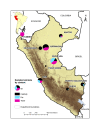Diversity and prevalence of zoonotic infections at the animal-human interface of primate trafficking in Peru
- PMID: 38324542
- PMCID: PMC10849265
- DOI: 10.1371/journal.pone.0287893
Diversity and prevalence of zoonotic infections at the animal-human interface of primate trafficking in Peru
Abstract
Wildlife trafficking creates favorable scenarios for intra- and inter-specific interactions that can lead to parasite spread and disease emergence. Among the fauna affected by this activity, primates are relevant due to their potential to acquire and share zoonoses - infections caused by parasites that can spread between humans and other animals. Though it is known that most primate parasites can affect multiple hosts and that many are zoonotic, comparative studies across different contexts for animal-human interactions are scarce. We conducted a multi-parasite screening targeting the detection of zoonotic infections in wild-caught monkeys in nine Peruvian cities across three contexts: captivity (zoos and rescue centers, n = 187); pet (households, n = 69); and trade (trafficked or recently confiscated, n = 132). We detected 32 parasite taxa including mycobacteria, simian foamyvirus, bacteria, helminths, and protozoa. Monkeys in the trade context had the highest prevalence of hemoparasites (including Plasmodium malariae/brasilianum, Trypanosoma cruzi, and microfilaria) and enteric helminths and protozoa were less common in pet monkeys. However, parasite communities showed overall low variation between the three contexts. Parasite richness (PR) was best explained by host genus and the city where the animal was sampled. Squirrel (genus Saimiri) and wooly (genus Lagothrix) monkeys had the highest PR, which was ~2.2 times the PR found in tufted capuchins (genus Sapajus) and tamarins (genus Saguinus/Leontocebus) in a multivariable model adjusted for context, sex, and age. Our findings illustrate that the threats of wildlife trafficking to One Health encompass exposure to multiple zoonotic parasites well-known to cause disease in humans, monkeys, and other species. We demonstrate these threats continue beyond the markets where wildlife is initially sold; monkeys trafficked for the pet market remain a reservoir for and contribute to the translocation of zoonotic parasites to households and other captive facilities where contact with humans is frequent. Our results have practical applications for the healthcare of rescued monkeys and call for urgent action against wildlife trafficking and ownership of monkeys as pets.
Copyright: © 2024 Mendoza et al. This is an open access article distributed under the terms of the Creative Commons Attribution License, which permits unrestricted use, distribution, and reproduction in any medium, provided the original author and source are credited.
Conflict of interest statement
The authors have declared that no competing interests exist.
Figures




References
MeSH terms
Grants and funding
LinkOut - more resources
Full Text Sources
Research Materials
Miscellaneous

